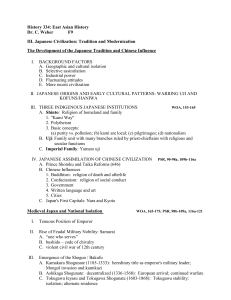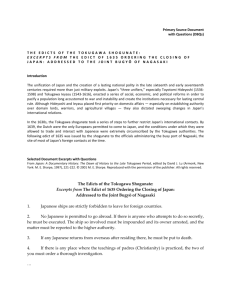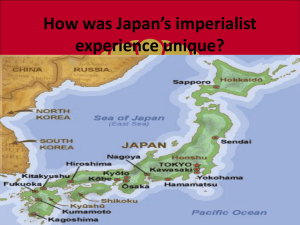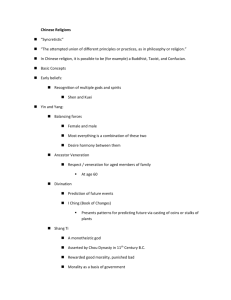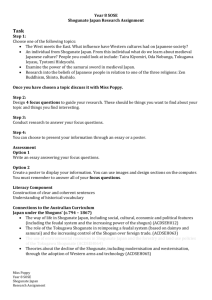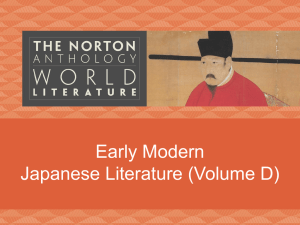Japan: Cultural Diffusion, Shintoism, & Tokugawa Shogunate
advertisement
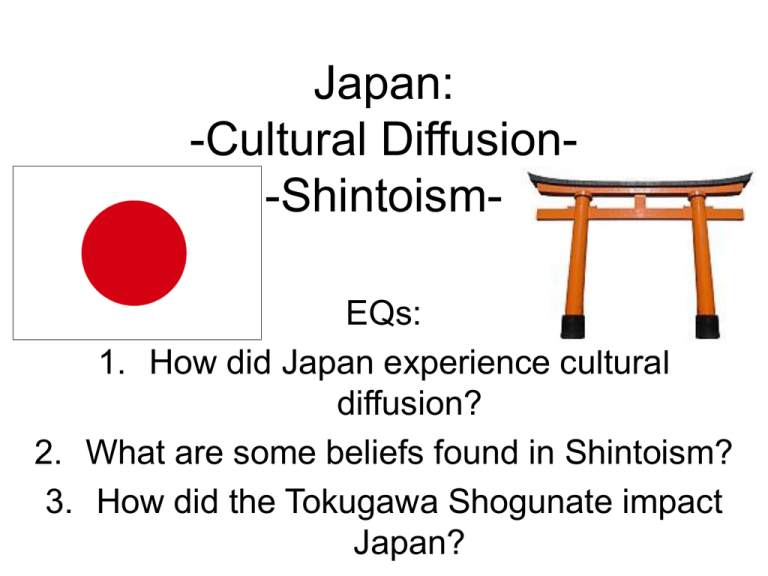
Japan: -Cultural Diffusion-ShintoismEQs: 1. How did Japan experience cultural diffusion? 2. What are some beliefs found in Shintoism? 3. How did the Tokugawa Shogunate impact Japan? Map of Diffusion • Japanese culture includes: – original traditions – ideas borrowed from Korea and China Japan & Korea • These cultures meet due to warfare and trade • Korea acts as a bridge between Japan and China • Korea introduces – Chinese writing system (c.500CE) – Buddhism Japan & China • C. 600CE = Japan sends nobles to study Chinese culture – During China’s Tang Dynasty, Japan imports ideas directly from China • 700-1100CE = Japan blends the best Chinese ideas with their own traditions – This creates Japan’s specific culture Japanese Language • C. 800CE = Japan adapts Chinese writing Chinese symbol for “life” • Japan has their own language Japanese symbol for “life” The Tokugawa Shogunate • In 1603, the Tokugawa shogunate was founded • This shogunate stabilized Japan by bringing the fighting daimyo under control • The Tokugawa ran a centralized feudal government • Japan’s economy prospered due to having a stabilized society • New seeds & farming techniques allow farmers to produce more food • Population grows • Trade increases – By 1638, the Tokugawa only allowed internal trade (among the Japanese islands) • Advances in culture – – – – Tea ceremony Landscape gardening Kabuki theater Haiku Customs & Art: China’s Influence • Tea drinking, tea ceremonies (Zen Buddhism) • Music, dancing, Kabuki Theater • Rock garden design & landscaping • Architecture – Pagoda style – Buddhist monasteries Belief Systems in Japan • As Japanese civilization developed, various religions were practiced – Shintoism – Buddhism – Zen Buddhism – Confucianism The Garan, the central temple complex in the town of Koyasan Shintoism • Japan’s traditional religion • Shinto = “the way”, or “the way of the gods” • To practice Shinto, one must worship the “kami” – Kami = spirits found in all living and nonliving things – Kami control the forces the nature • Attempt to win the favor of the kami through praying, offerings, and visiting shrines “Tsumairi” style shrine Effects of Shintoism • Followers help unite all of Japan • Strong respect for the natural world in Japan • Shrines built in places of natural beauty & they appear throughout Japan Torii Gate: The Torii gate, as seen above, is the entrance to a Shinto shrine; the gate may be on land or water Beliefs from China to Japan • Zen Buddhism develops in China and spreads throughout Japan • Confucian ideals of proper behavior and social order are popular in Japan • Zen Buddhists value peace, simple living, nature, and beauty • Japan likes the ideas of family loyalty, honoring parents, and the respect for education Exit Ticket • On 1/2 sheet of paper, answer the following questions in complete sentences. 1) How did Japan experience cultural diffusion? Describe two examples. 2) What is a major belief found in Shintoism? 3) How did the Tokugawa shogunate influence Japan?



